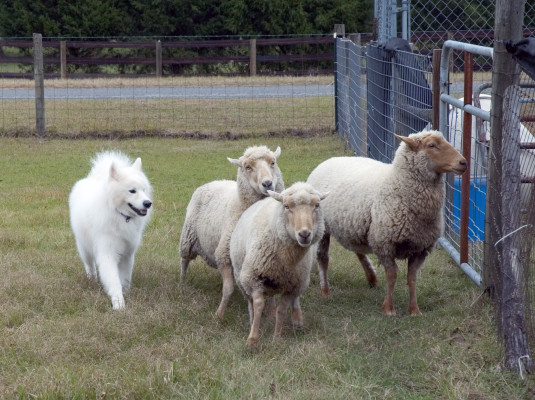Herding

Samoyeds are, to say the least, a multi-purpose dog. The harsh climate in which they lived precluded having domesticated animals that had only one function. Limited food supplies required that they be proficient in more than one attribute. Thus it was that the breed took up the role of an Arctic shepherd.
Like many nomadic peoples, the Samoyede’s main source of sustenance and symbol of wealth and power were their herds of livestock, in this case the tundra caribou, or reindeer. With the adult males weighing in excess of 1000 pounds, these wandering herds provided food, shelter, and most of the necessities of life on the tundra, much like the bison herds of the American plains did for the American Indians. The difference was that in the cold, barren Arctic, the Samoyede people had to keep in close contact with the herds to ensure that they could make use of them.
The type of herding that this lifestyle required was a combination of tending and driving, with some fetching thrown in when members of the herd would stray from the main group. The people would set up a camp in the center of a likely grazing area and then place a ring of dogs around the camp to keep the herd from trampling through their respective living rooms. A second, large ring of dogs were placed on the outer edges of the grazing herd to keep the main body of reindeer together and prevent stragglers from wandering off onto the tundra. When the grazing was depleted, everything was packed up and the herd was driven to a new site where the process was repeated as before.
Since it has been over 100 years since any Samoyeds were used for this purpose, finding a Sammie that exhibits more than a passing interest in herding is a bit serendipitous at best. While the herding instinct may have been bred for by those Arctic tribesmen, today’s breed maintains that
legacy in a very hit and miss fashion. Today’s Sammies work because they want to please their owners, or because they still retain some of the primitive pack hunting urge. The intensity of their desire can vary greatly from one exposure to the next, and is not anywhere near the force that motivates such breeds as the Border Collie. Samoyeds work with their owners, and easily become bored with repetitions. They resent being forced to work a particular way, and will often find their own style of herding, especially if it is more active or more fun.
In general, Samoyeds are upright, loose-eyed working dogs. This means that they use their whole body to influence the movement of the livestock. This requires that they usually work closer to the stock than a breed that controls through the use of “eye.” In this respect, they are very similar to such other herders as Australian Shepherds or Shetland Sheepdogs. Samoyeds also tend to shoulder or chest livestock to push them in the direction that they want them to go, a trait that I have only seen in one or two other herding breeds. If working cattle, they should be taught to keep their distance, as their upright nature make them prime targets for a kick. They are not afraid to work in confined areas with stock, and I have seen even puppies jump on top of milling groups of sheep to break them up.
I wholeheartedly encourage any Samoyed owners to have their dogs tested for herding instinct. The training must be with you and your dog as a team; the harder you push them, the more they will resist the training. But the results can be more rewarding than anything I have ever attempted with this breed. Remember, Samoyeds are the symbol of versatility.
-By Louis Thompson, Omega Samoyeds